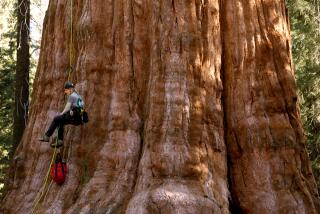Yellow Death Stalks Florida Coconut Palms : Environment: An insect-carried lethal disease is spreading across the state. Earlier, it killed thousands of plants in the Caribbean.
- Share via
FT. MYERS BEACH, Fla. — Victor Yingst is on the trail of a killer on Florida’s palm-shaded Gulf coast.
He knows the stalker’s methods by heart.
“First the coconuts fall, then the fronds turn a bright yellow and soon the tree is dead,” said Yingst, who has spent more than three years battling lethal yellowing disease for the Lee County Extension Service.
After wiping out thousands of palms in the Caribbean and southeastern Florida, the infestation is spreading into one of the last untouched regions for the majestic Jamaican tall palm and other susceptible exotic species.
The insect-carried disease--moving inland from beaches--has agriculture experts fearing a recurrence of the palm die-offs in southern Florida in the 1970s. Tourism officials worry about a change in the tropical appeal of southeastern Florida.
“Lethal yellowing is sort of like a fire,” Yingst said. “If left unchecked, it will spread farther and farther. It could really rob this area of its special beauty.”
Although lethal yellowing has been studied for nearly 100 years, there is no known cure. But recently tree inoculations and plantings of resistant palms have helped somewhat to contain the disease, caused by a cellular organism called mycoplasmas that lives on the palm fronds’ soft core.
Trees usually die within three to six months after the first symptoms appear.
The earliest known reference to a coconut tree disorder was made in 1834 on Grand Cayman Island. By the late 19th Century, scientists were examining lethal yellowing in Jamaica, where the coconut crop was a valuable export.
Lethal yellowing jumped over to the Florida Keys in the 1950s and moved onto the mainland near Miami in 1971. Currently, the disease has claimed about 200,000 coconut palms and nearly 100,000 other species in Florida as far north as Jupiter, about 80 miles from Miami, according to the University of Florida.
In Texas, lethal yellowing has spread to date palms, creating concern in the date-growing regions of Arizona and California. Overseas, the disease ranges from West Africa across the Caribbean to Mexico’s Yucatan peninsula.
“What you’re left with is a trunk--like a telephone pole--that just rots until it eventually falls over. It’s really ugly,” Yingst said.
As head of the Lee County lethal yellowing control effort, Yingst has organized groups of residents and landscapers to monitor its progress and inject healthy trees with a tetracycline-based antibiotic. Also, resistant palms such as the popular malayan dwarf variety are being planted around healthy coconut palms as a buffer.
Sherry Marinello, who operates a landscaping service, said she has inoculated about 1,300 trees in Ft. Myers and Ft. Myers Beach, where the disease was first spotted on the Gulf Coast.
“To see a picture of what this place looked like two years ago and what it looks like now would shock you,” she said. “It’s a serious problem that could really change the character of this place if it’s not stopped.”
More to Read
Sign up for Essential California
The most important California stories and recommendations in your inbox every morning.
You may occasionally receive promotional content from the Los Angeles Times.










